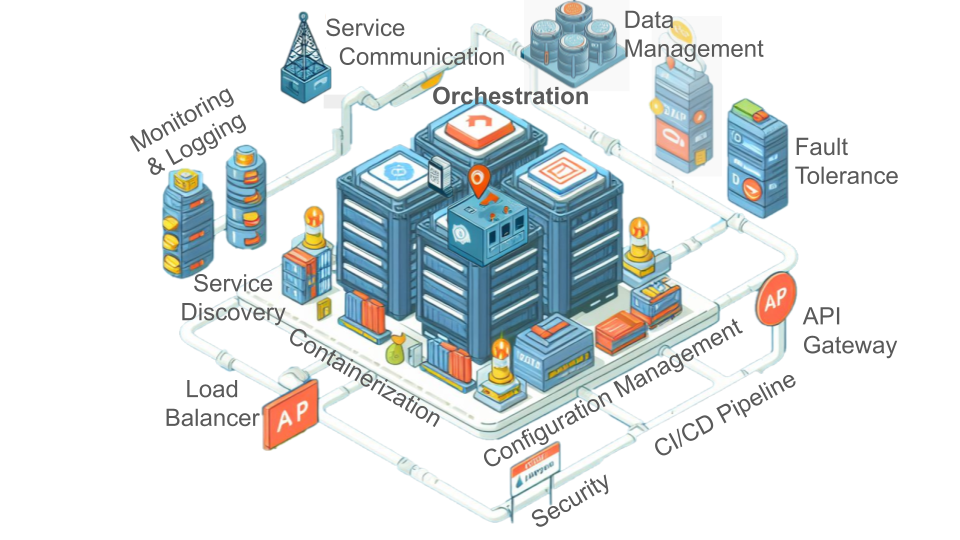Leverage the Kubernetes Power: A Blueprint for a Microservices Orchestrator to Maximize Efficiency
 La Rebelion Labs
La Rebelion Labs
This post is part of a series of three. In this post, we'll explore the key components of a robust microservice architecture and how they can be implemented using Kubernetes resources. The second post will dive deeper into each component, providing examples of how to implement them using Kubernetes. The third post will be a hands-on guide, demonstrating these implementations with Camunda BPM as an example of implementing it as if we were migrating to a microservice architecture based on KMOP (Kubernetes Microservices Operator Pattern).
With this series, I'm planting the seed of an idea (KMOP), and I would love to hear your thoughts on it. Let's get started!
The Microservices Orchestration Challenge
Microservice architecture breaks down applications into smaller, independent services that communicate over a network. Each service focuses on a specific business function, making the system more flexible and scalable. But what are the key components of a robust microservice architecture? Let's dive in.
Kubernetes: The Microservices Orchestrator
Kubernetes (K8s) is an excellent platform for deploying and managing microservices due to its powerful orchestration capabilities. By leveraging Custom Resource Definitions (CRDs) and Operators, we can extend Kubernetes' functionality to map each essential component of a microservice architecture.
Kubernetes Resources
A Kubernetes resource is an API object representing the desired state and intended behavior of a specific aspect in the cluster. Kubernetes resources are perfect for defining and managing the components of a microservice architecture. They can be extended using CRDs and Operators to provide advanced functionality.
Key Components of a Robust Microservice Architecture
Here are the key components that a robust microservice architecture must include and how they can be implemented using Kubernetes resources.
1. Service Discovery
Purpose: Enables services to find and communicate with each other without hardcoding network locations.
Examples: Consul, Eureka, etcd.
Kubernetes Component: Built-in service discovery through Kubernetes Services and DNS.
Alternative: Implement a CRD for a custom service registry to extend Kubernetes' service discovery capabilities.
2. API Gateway
Purpose: Acts as a single entry point for all client requests, handling routing, authentication, rate limiting, and load balancing.
Examples: Kong, Zuul, Apigee.
Kubernetes Component: Use Ingress resources to route traffic to microservices. Ingress Controllers like NGINX Ingress or Traefik.
Alternative: Deploy an API Gateway like Kong or Ambassador, managed by Operators.
3. Load Balancer
Purpose: Distributes incoming network traffic across multiple instances to avoid bottlenecks.
Examples: NGINX, HAProxy.
Kubernetes Component: Kubernetes Service of type LoadBalancer.
Alternative: Use a custom CRD to manage advanced load balancing strategies with NGINX or HAProxy.
4. Configuration Management
Purpose: Centralize configuration management to ensure consistency and ease of updates.
Examples: Spring Cloud Config, Consul, etcd.
Kubernetes Component: ConfigMaps and Secrets for configuration data and sensitive information.
Alternative: Develop an Operator to sync configuration data from external sources like Vault or Spring Cloud Config.
5. Service Communication
Purpose: Facilitates communication between microservices, either synchronously (HTTP/REST, gRPC) or asynchronously (message queues like RabbitMQ, Kafka).
Examples: REST, gRPC, RabbitMQ, Kafka.
Kubernetes Component: Use Kubernetes Services for internal communication. Native support for service-to-service communication using ClusterIP Services and networking policies.
Alternative: Develop a CRD for managing service meshes or custom message queues.
6. Service Monitoring and Logging
Purpose: Tracks the health, performance, and usage of microservices, aiding in issue identification and troubleshooting.
Examples: Prometheus, Grafana, ELK Stack (Elasticsearch, Logstash, Kibana).
Kubernetes Component: Use Prometheus and Grafana. Deploy the Prometheus Operator.
Alternative: Develop a CRD for custom monitoring and logging solutions with OpenTelemetry.
7. Containerization
Purpose: Encapsulates each microservice in a container for consistency across environments.
Examples: Docker, Kubernetes.
Kubernetes Component: Use Docker containers and private registries. Leverage Helm for managing applications.
Alternative: Develop a CRD for custom containerization solutions. Use tools like Skaffold for local development and deployment of microservices.
8. CI/CD Pipeline
Purpose: Automates the build, testing, and deployment processes for rapid and reliable delivery.
Examples: Jenkins, GitLab CI, CircleCI.
Kubernetes Component: Use Jenkins X or Tekton for cloud-native CI/CD pipelines.
Alternative: Develop a CRD for custom CI/CD pipelines, using GitOps principles.
9. Security
Purpose: Protects the architecture from unauthorized access and attacks through practices like authentication, authorization, and encryption.
Examples: OAuth2, OpenID Connect, JWT.
Kubernetes Component: Use Kubernetes RBAC and Pod Security Policies. Implement network policies and Secrets. Implement network policies to control traffic between microservices, and use Secrets for storing sensitive information.
Alternative: Create a custom CRD and Operator for managing security policies, integrating with tools like OPA and Vault.
10. Data Management
Purpose: Manages data across microservices, ensuring consistency and integrity.
Examples: Database per service pattern, Event Sourcing, CQRS.
Kubernetes Component: Use StatefulSets and Operators for managing databases.
Alternative: Develop a CRD for custom data management solutions, implementing patterns like Event Sourcing and CQRS with automated backups, scaling, and failover. Use tools like KubeDB for managing stateful applications on Kubernetes.
11. Fault Tolerance and Resilience
Purpose: Ensures the system can handle failures gracefully and continue operating with minimal disruption.
Examples: Circuit breakers (Hystrix), retries, and timeouts.
Kubernetes Component: Use liveness and readiness probes, Pod Disruption Budgets, and Horizontal Pod Autoscaling.
Alternative: Develop a CRD for custom fault tolerance solutions, using tools like Resilience4j, Sentinel, SmallRye Fault Tolerance, and Spring Retry for implementing service mesh patterns like circuit breaking and retries for handling failures in microservices.
12. Orchestration and Coordination
Purpose: Manages the lifecycle of microservices, ensuring efficient deployment, scaling, and maintenance.
Examples: Kubernetes, Docker Swarm.
Kubernetes Component: Native Kubernetes orchestration and scheduling features.
Alternative: Develop an Operator for advanced orchestration scenarios like blue-green deployments, canary releases, and chaos engineering (e.g., LitmusChaos). Use tools like Argo Workflows or Tekton Pipelines for defining complex workflows and automating tasks across microservices.
Conclusion
Incorporating these components ensures a microservice architecture is scalable, resilient, and maintainable. This setup allows teams to develop, deploy, and manage services independently, leading to faster delivery and more robust applications.
In the next post, we'll explore popular frameworks and tools, and see how KMOP (Kubernetes Microservices Operator Pattern) can extend Kubernetes' functionality to support the microservices components.
Stay tuned for the next post in this series! Let's revolutionize how we build and manage modern applications together.

Subscribe to my newsletter
Read articles from La Rebelion Labs directly inside your inbox. Subscribe to the newsletter, and don't miss out.
Written by

La Rebelion Labs
La Rebelion Labs
I was thinking about it, I feel that the concept of entrepreneurship is quite similar to the idea of being a Rebel. As a 'rebel,' I am passionate about experimenting and creating novel solutions to large problems.